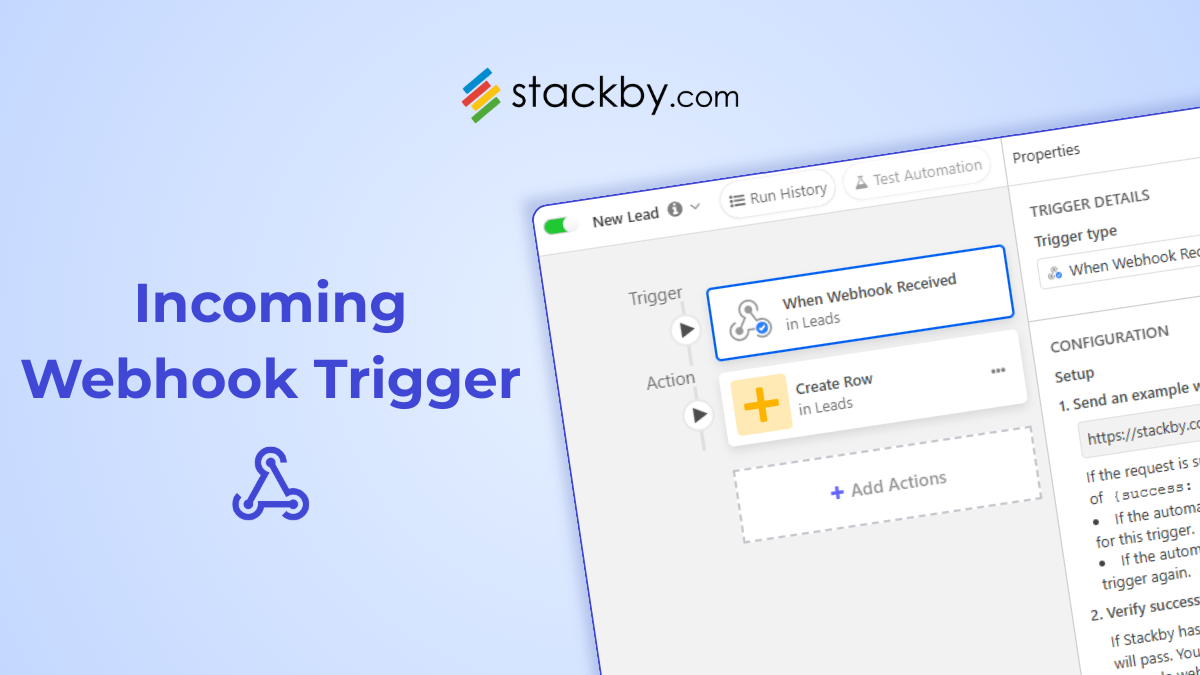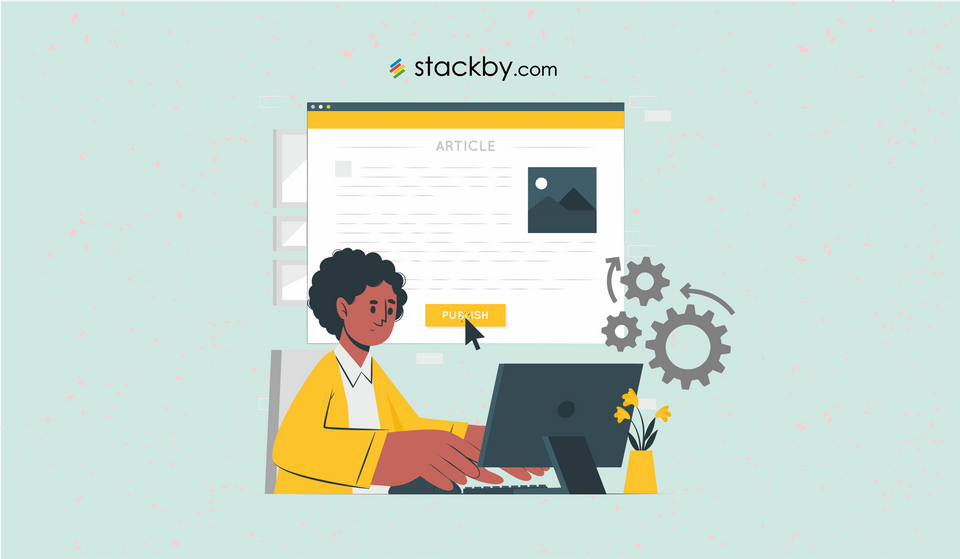Introducing Stackby's Incoming Webhook Trigger for Real-Time Automation
Stackby’s new Incoming Webhook Trigger lets you bring live data into your workspace from external apps—automating workflows and eliminating manual updates.

Introducing Stackby's Incoming Webhook Trigger
In today's fast-paced digital landscape, efficient data integration is crucial for maintaining streamlined operations. Recognizing this need, Stackby launched internal automations in 2024 and has now expanded its capabilities by introducing the Incoming Webhook Trigger. It’s exactly what it sounds like, a way to bring live data into Stackby from external platforms the moment something happens.
It helps bridge your tools and Stackby with zero manual effort. So instead of copy-pasting stuff or checking your email every time a new form is submitted… Stackby just updates itself.
And this isn't a small niche feature. The global digital process automation market is projected to hit $44.4 billion by 2033, growing steadily at 12.8% CAGR. So yeah, automation isn’t slowing down anytime soon.
What Are Webhooks?
Webhooks are automated messages sent from one app to another when a specific event occurs. Unlike APIs that require frequent requests to check for updates, webhooks push data in real-time, ensuring seamless and instant communication between tools. They act as a trigger, when something happens in one app, it notifies another app to take action.
For example, when a new lead fills out a Typeform, a webhook can automatically send the data to Stackby, updating your CRM instantly. Similarly, if a customer makes a payment on Stripe, the webhook can log the transaction details in your Stackby database, eliminating manual data entry and reducing errors.
What is the Incoming Webhook Trigger?
An Incoming Webhook is a unique URL provided by Stackby that external applications (Zapier, Slack, Shopify, or a custom app) can send data to. When these applications send a JSON payload to this URL, it triggers predefined actions within Stackby like creating a new row or updating a column, enabling seamless communication between tools and automating workflows across platforms.
For example, organizations using Slack for team communication can set up an Incoming Webhook Trigger to automatically log messages in Stackby whenever a specific keyword is mentioned in a channel. Similarly, businesses using Zapier can connect different apps, such as logging new form submissions from Typeform into Stackby without manual input. This level of automation eliminates repetitive tasks, reduces human error, and ensures that critical data is always up to date.
By bridging third-party tools with Stackby, teams can improve efficiency, streamline cross-platform workflows, and maintain a single source of truth for all their business operations. Whether it’s syncing customer inquiries from a chatbot, tracking payment updates from Stripe, or logging new support tickets from Freshdesk, the Incoming Webhook Trigger empowers organizations to create real-time, automated workflows that enhance productivity and decision-making.
Key Benefits:
- Real-Time Data Integration:
No more data gaps. Automatically update your Stackby tables with information from external sources as events occur, ensuring your data is always current.
- Enhanced Workflow Automation:
Set trigger specific actions within Stackby based on incoming data, then let the system run. Fewer clicks, fewer mistakes.
- Customizable and Flexible:
Define tailored workflows that respond to the unique needs of your business, allowing for a high degree of customization.
Getting Started:
- Generate a Webhook URL: Go to Stackby table > Automations > Add Trigger > When Webhook Received > Copy Link
- Configure External Application: Set up your external tool to send data to the generated webhook URL. Ensure the data format aligns with Stackby's requirements.
- Define Automation Actions: Specify the actions Stackby should perform upon receiving data, such as creating a new row or updating an existing one.
- Test and Deploy: Conduct thorough testing to confirm that the integration functions as intended before deploying it in a live environment.
Real Examples of How Teams Are Using It Right Now
Let’s move from theory to practice. Here are some actual ways users are setting up incoming webhooks inside Stackby:
🛒 Bring Shopify Orders into Stackby
Online stores are using incoming webhooks to automatically sync new Shopify orders into a Stackby table. Order details like product name, quantity, customer name, and delivery status are added as new rows, so teams can manage fulfillment, inventory, or tracking from one place. No CSV exports, no middleman. It’s real-time e-commerce data, directly in your project pipeline.
📝 Bring Typeform Responses into Stackby
Got a feedback form, demo request, or hiring application on Typeform? Now, every time someone fills it, the webhook instantly pushes their response into your Stackby table. That means your CRM or hiring pipeline is always up to date, without needing Zapier or Google Sheets as a middle step.
📄 Bring Google Form Responses into Stackby
Google Forms might be free and easy, but it doesn’t play nicely with other tools by default. Now, teams use incoming webhooks to send new Google Form responses into Stackby. Whether it’s event registrations or internal surveys, your Stackby dashboard updates itself the moment someone hits “Submit.”
These are just three examples, but this works with any app that supports webhook requests, like Pabbly, Make (Integromat), or custom backend systems.
Some More Practical Use Cases:
- Lead Management: Automatically add new leads to your Stackby CRM when a potential customer submits a form on your website.
- Order Processing: Update inventory levels in real-time as orders are placed through your e-commerce platform.
- Project Tracking: Log updates from external project management tools to maintain a unified view of progress within Stackby.
- Finance & Expense Tracking: Capture new transaction records from payment gateways like Stripe or PayPal in real-time.
Automations should feel like magic, not maintenance. And Stackby’s Incoming Webhook Trigger is one step closer to that. Whether you're managing leads, tracking inventory, or collecting feedback, you can now streamline it all into a single workspace that updates itself.
By creating a real-time, cross-platform workflow, your team can focus on what actually matters, strategy, not manual updates.
Stay updated with the latest features and upcoming enhancements by visiting What's New. Plus, if you have a specific automation feature in mind, you can request it directly through the feature request form.
If you need help setting it, just drop us a message or visit our support docs.
More advanced automation features are already in the works, so stay tuned.

![Best 14 HR Database Software for Recruitment Agency [Free+Paid] [2025]](/blog/content/images/size/w960/2024/04/stackby--hr-database-software-blog-post-5.3.jpg)
![A Simple Guide on Workflow Management Software [Updated 2025]](/blog/content/images/size/w960/2021/12/work-management-blog.png)
![Step by Step Guide on How to Build Forms in a Database [2025]](/blog/content/images/2022/03/form-database-blog.png)
